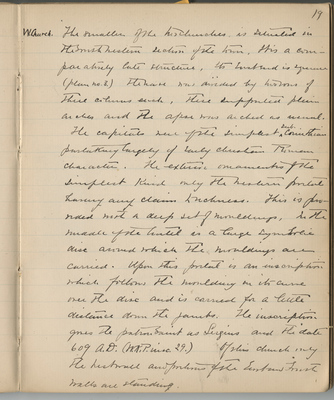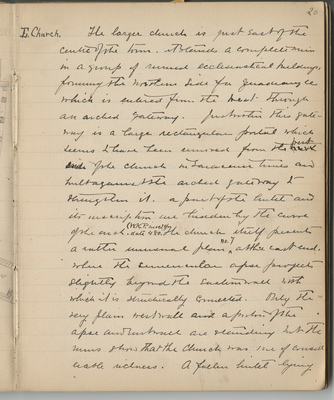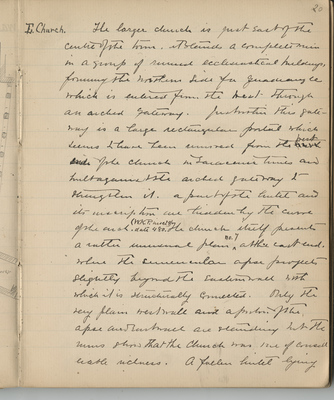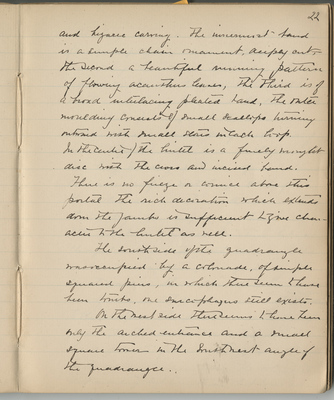Pages
BSY_FB_06_p019
19
W. Church. The smaller of the two churches is situated in the south western section of the town. It is a comparatively late structure, its east end is square (plan no. 3) the nave was divided by two rows of three columns each, these supported plain arches and the apse was arched as usual.
The capitals were of the simplest sub-corinthian partaking largely of early christian Roman character. The exterior ornaments of the simplest kind only the western portal having any claim to richness. This is provided with a deep set of mouldings, in the middle of the lintel is a large symbolic disc around which the mouldings are carried. Upon this portal is an inscription which follows the moulding on its curve over the disc and is carried for a little distance down the jambs. The inscription gives the patron saint as Sergius and the date 609 A.D. (W.K.P. insc 29). Of this church only the West wall and portions of the East and South walls are standing.
BSY_FB_06_p020
20
E. Church. The larger church is just east of the centre of the town, it stands a complete ruin in a group of several ecclesiastical buildings, forming the northern side of a quadrangle which is entered from the west through an arched gateway. Just within this gateway is a large rectangular portal which seems to have been removed from the west of the church in Saracenic times and built against the arched gateway to strengthen it. A part of the lintel and its inscription are hidden by the curve of the arch ^ (W.K.P. insc.24) ^ date 480 A.D.. The church itself presents a rather unusual plan ^ (no. 7) ^ at the east end where the semicircular apse projects slightly beyond the eastern wall with which it is structurally connected. Only the very plain west wall and a portion of the apse and east wall are standing but the ruins show that the church was one of considerable richness. A fallen lintel lying
BSY_FB_06_p020
20
E. Church. The larger church is just east of the centre of the town, it stands a complete ruin in a group of several ecclesiastical buildings, forming the northern side of a quadrangle which is entered from the west through an arched gateway. Just within this gateway is a large rectangular portal which seems to have been removed from the ^West ^ of the church in Saracenic times and built against the arched doorway to strengthen it, a part of the lintel and its inscription are hidden by the curve of the arch ^ (.W.K. P. Insc 240) ^ date 480 A.D.. The church itself presents a rather unusual plan ^ (No 7) ^ at the East end, where the semicircular apse projects slightly beyond the eastern wall with which it is structurally connected. Only the very plain west wall and a portion of the apse and east wall are standing but the ruins show that the church was one of considerable richness. A fallen lintel lying
BSY_FB_06_p021
21
face down is among the finest specimens of its kind that we have seen, it bears an insc. in Greek (W.K.P. insc. 25) dating to 401 AD.
The nave was divided by 2 rows of massive columns and arches. The capitals are of a peculiar pattern which is in no sense a modification of one of the GK. orders. They have a square plinth and a deep echinus ornamented with perpendicular flutings, at the neck is a simpler bead moulding.
South of the church, on the east side of the quadrangle was a finely constructed rectangular building, completely destroyed for building purposes, with only its western portal standing and portions of a smaller doorway to the south.
This western portal is by all odds the most beautiful we have found in this region. The decoration which extends across the lintel and down the jambs consists of a variety of mouldings interspersed with bands of foliate
BSY_FB_06_p022
22
and bizarre carving. The innermost band is a simple chain ornament, deeply cut, the second is a beautiful running pattern of flowing acanthus leaves, the third is of a broad interlacing pleated band, the outer moulding consists of small scallops turning outward with small stars in each loop. In the center of the lintel is a finely [mosylet] disc with the cross and incised band.
There is no frieze or cornice above this portal the rich decoration which extends down the jambs is sufficient to give character to the lintel as well.
The south side of the quadrangle was occupied by a colonnade, of simple squared piers, in which there seem to have been tombs, one sarcaphagus still exists.
On the west side there seems to have been only the arched entrance and a small square tower in the southwest angle of the quadrangle.





